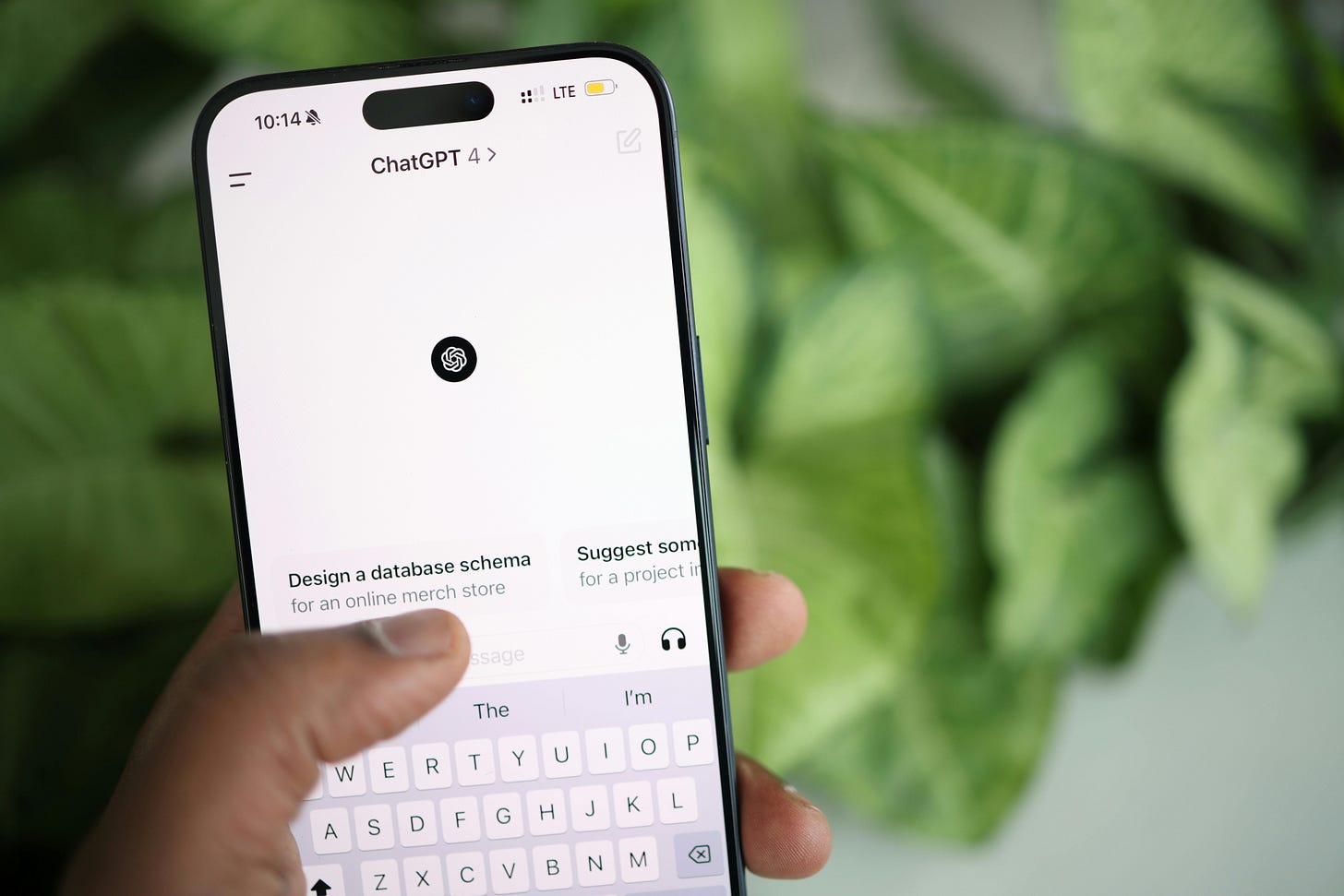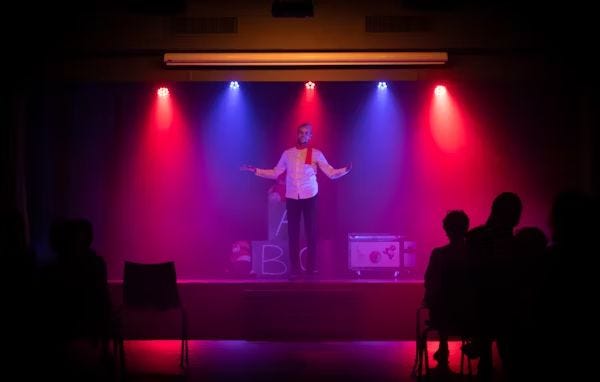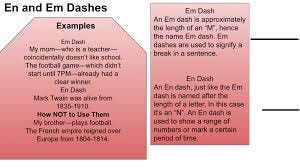The Continued Rise of Artificial Intelligence at the Edinburgh Fringe
FIve worrying examples from the world's largest arts festival
Artificial intelligence or AI became more prominent at the world’s largest arts festival, the Edinburgh Festival Fringe this year.
There was already use of generative AI in 2024 and a hint of it in 2023.
In this short article I am going to discuss five examples of it I encountered at the 2025 Edinburgh Fringe. Some of these examples refer to controversial circumstances and at least one investigation by one of the UK's most prominent comedy websites.
Each example is a “use case” that offers up both positive and negative observations, and most cases represent the most prevalent deployment of so-called “generative AI”, a version of AI which is largely a form of artificial impersonation branded as artificial intelligence.
Yes, I am starting with that controversial statement because there are genuinely expressed expert views that the currently so called “generative AI” is more of a brand than a genuine example of artificial intelligence.It ’s severe limitations as genuine artificial intelligence have been often explored by academics. In terms of being real AI, it often falls short.
All of the examples in this article represent both threats and opportunities with the threats perhaps far more significant than the current opportunities which are very much grounded in hype and selective storytelling akin to new medications offered online which only report the anecdotal positives rather than presenting the whole statistics which would show a much flatter curve and even a downward one.
The Gartner hype cycle is a model much used, often critiqued but potentially useful for identifying the realities of such technologies, and the key reality here is that though the hype suggests a good news story, most of the data identifies an increasing trend towards rising expectations turning into disappointment and even (according to The Economist), a trough of disillusionment.
So, how did that manifest itself at the world’s largest arts festival?
Example 1: Theatre Making and Presentation
Example 1 is about the use of AI in arts and entertainment making and performance. Here we have the replacement of human-voiced and played soundtracks and voiceover with artificially created ones, most of which are not producing original content but are simply mimicking or substituting the human element. What we have here is replication (plagiarism). The opportunity here is to save money, and specifically to reduce the wage bill by replacing voiceover artists with AI generated content that sounds the same or almost the same as human content generation in the form of voiceovers, singing, and sound effects originally composed and produced by humans. This includes editing of content. Essentially foley work is superseded by AI. Similarly non-human sound effects are also replaced by AI and this is not new as sound effects recordings have been available for decades. The key elements here are the replication, or complete replacement of human wage costs with zero or little cost generated by AI. There are other, largely ignored costs though, such as energy and environmental costs.
As we arrived at the end of the Fringe, further use of AI was coming to light, including the creation and use of projected visual images such as paintings projected in some way into the performance or produced and put into frames for certain scenes or AI generated along with scenery backdrops
Example 2: Reviews Written by AI
The second case example is much more controversial and a recent investigation by Chortle identified examples where reviews were created entirely by AI by a PR agency giving positive star ratings to comedians and other performers who were actually on the books as clients of the agency. In one case at least the reviews were published before the performance tour had even started.
The method for identifying that this had been used by AI was as simple as asking AI itself what the likelihood was with an evidence trace where possible and the result was 100% likelihood, unlike the usual doubt around 60% which such investigations often throw up, meaning it is not usually possible to prove that something has been written by AI. In this case it was so obvious even from a basic and cursory analysis of that content that AI had been used. It was also not denied by those perpetrating it.
The impact on several comedians who spoke up in public was significant enough for them to say it affected their mental health as their self-esteem collapsed when realising that a review of their work at the level of four or five stars had actually been generated by AI and not by an observing human being in the flesh. One said it made them feel sick and another said they felt gutted.
Certainly on the grapevine and in general conversations around the Edinburgh Fringe over a month I heard people justifying their use of AI with anything from only using it as a spell, grammar and punctuation checker, to carrying out research. No one admitted using it to directly write reviews but many hinted that they were using it as a co-author at least. Sometimes a sort of murky silence clouded these conversations, which were brought quickly to an end, and it made me wonder what was not being said and why those conversations were not allowed to pursue further.
Example 3: The Problem of the Em Dash
Anecdotally there was also the problem of the famous em dash where a long hyphen, which is not easy to produce on a keyboard, becomes prominent in the text suggesting the use of AI. Of course it is easy to prompt AI to remove those em dashes but much content that I saw in reviews had them prominently there. As the editor of a respected online review publication, Fringe Review, there were two specific instances where I had to challenge one of our own reviewers on their use of AI. One admitted it but luckily this was on their first review and they immediately apologised, suggesting they thought it was allowed even though this is stated very clearly by Fringe Review that we should not be using AI in any significant way to write reviews or replace human activity in the writing process. This was quickly rectified.
Perhaps much more worrying was the second challenge where the reviewer very quickly evidenced that they were not using AI and they pointed to their keyboard having the em dash as one-touch accessible on their keyboard because they are an academic and use it often. Several reviewers are noting that when asking AI itself their own writing seems to bring up a higher probability according to the AI itself that they have used AI when all they have actually used is some very clear writing in their own academic style. This was stressful as it suggested that authors are cursed or doomed to be confused with AI simply because they write in a similar way. AI itself of course is trained as a large language model on literally trillions of amounts of data so this will come up from time to time because the AI itself is impersonating the academic style. Without absolutely reliable tools to identify the difference this confusion is going to grow and will certainly infect the higher end of quality review writing
Example 4: Marketing and Promotion
A third example is the use of AI in marketing and promotion. I found little hard evidence of video material in press releases and other promotional material being used to create that content but it is certainly used to alter it and so the images we are looking at, for example in rehearsal shots, have been doctored and once again this is not new but it has become very easy to do this. This can actually create a false impression of a show and its quality or even vision and intentions in the same way that altering images has always done. It can make shows look higher budget, tighter and more inviting when actually what we go to see is much more amateur or of lower quality but it is too late then and the promise of a great show becomes a review of a poor one. Creating exaggerated content, distorted in terms of truth, and touched up images is a form of deception and we were certainly receiving press releases that contained images that were not authentic, essentially meaning this is a false promise.
This will only get worse as will the text itself within press releases which will be written more and more by AI and as with AI generated reviews they lack authenticity and border on deception. Several of our reviewers found it very easy to identify this writing and most of it was cliched and of poor quality, actually reducing the chances of performing companies getting a review in the first place. These companies should carefully consider either their prompting skills so that they produce higher quality content or rely more on human beings at least to stay in the loop and check work properly.
Within this category there are also examples of preview copy, articles and interviews being partly or totally AI generated leading to a sense of being deceived, or a general feeling that we are being immersed in a kind of mediocrity which reduces the motivation and energy that reviewers might have for going to see shows. It can lead to skim reading or the avoidance of content where reviewers and authors simply end up relying on their own gut instincts which may not be reliable if proper information has also augmented that decision-making process about whether to interview somebody, follow up with articles or review.
The degradation of journal content and journalistic material will continue into the future. Writers will get cleverer with prompting AI until AI gets clever at prompting itself and the human will then be out of the loop.
My own experiments show how interviews, preview articles, as well as reviews can be easily faked. But it is worse. This is taking place now in live comedy where a reviewer simply puts their phone on to an app that records the entire gig and then prompts AI to write a review out of it.
Example 5: Automation and Infrastructure
In a very different example of AI we go beyond the more recent developments in generative AI to find that automation and intelligent machine learning have created the ability to run entire lighting decks using AI without the need for human beings. Similarly the multi-billion dollar video industry and videography are already being augmented and will be replaced by AI unless steps are taken to consider the specific unique creative value of humans capturing content visually or through audio.
Not only is the image capture used by AI with developments in drone technology enhancing what is possible, but the editing process itself is already being affected by AI.
Soon entire shows will be run by AI technology in lighting and sound and venues will have AI based security and possibly even ushering.
There are clearly some examples here but one should also look at the current high energy costs of even one AI prompt and none of this is being measured. If we thought that paper flyering was environmentally unsustainable, Fringe festivals such as the Edinburgh Fringe will become the worst offenders in unsustainable use of AI and other digital technology to replace human and physical processes.
Reflections and Consequences
It feels to me like these are early days at the moment and it is very unclear if proper discussion is taking place around the ethical and moral consequences as well as the risks of hacking and AI failing or hallucinating when AI is given control over health and safety. It will not be long before we get the first disaster stories of venues going into severe and critical accident mode because of the failure of this or that technology. It seems to me at the moment that these conversations are not really taking place but the financial pressures in the arts are such that many performers feel they have no choice but to embrace AI. This is leading to a one-sidedness against it without sharing best practice and seeing what the opportunities for AI could be.
Using AI to augment lighting and sound to create new and even dazzling creative possibilities could positively disrupt artistic possibilities as well. The use of AI to ensure that reviews are posted and shared widely and other time consuming and often mind numbingly boring admin processes could definitely free people up for more creative work. But once again we do have to ask what humans would be doing if their jobs are replaced using this technology. Maybe that does create at least the possibility of wondering what kind of society we want and how we want the arts to operate. Is it sustainable to be paying people such low hourly rates to be carrying out such tedious admin tasks.
Certainly for reviewers, proofreading, punctuation and grammar checking are all time stealers and high quality AI may well become tools that really help us in our process of reviewing and publishing those reviews as well as checking their quality. Similarly background research and accuracy could certainly be augmented by AI and become a real benefit ensuring that more shows could be reviewed in the same amount of time. Whether AI observing or recording art and then providing recommendations to writers is something we want to happen is certainly going to become viable soon.
What is not taking place apart from on the very fringes of the frenetic arts festival such as the Edinburgh Fringe are proper deep conversations, scrutiny, applied academic research, ethical debate and any real considerations of the effect of all this on the economic underpinning of the arts.
I believe it is time to have these conversations and for government to get serious about funding research in this area. We need to know what the good news stories are and take them beyond anecdote to proper evidence-based case examples drawing out what actually works and can be a benefit to the people involved.
We need to be open about the hype and understand why we are operating in the trough of disillusionment with these technologies and step away from the idea that AI has arrived early simply because it has been branded, when the real technology is largely impersonating human beings and doing such a good job of it that it often leads to clumsy implementation, job losses, and the degradation of the very thing that we are here to celebrate, which is the highest quality creativity and artistry presented in events such as the Edinburgh Fringe.
A Personal Note
I sat in the café and dictated this article straight from my head straight onto the virtual paper. Every thought in this article is my own and I have checked it to ensure that is the case. But I used AI to check its UK English, grammar and punctuation.
I asked it to suggest some headings and to point out where sentences did not make sense and to act as a kind of helpful assistant. I noticed it constantly wants to cut things down, divide them into broken bits of text with hyphens in between, and often tries to insert a kind of insipid, mediocre language that tries to please the reader. Every time I have used this tool to experiment with it, it keeps doing this behaviour.
If I give it a lot of freedom in my prompt to actually rewrite it, it can often go into over generation where it adds unnecessary context and tries to talk up the content. Because it also has some kind of programming to not deliver too many words it then cuts it down clumsily and I end up with something that initially reads as if it is impressive and flows well, but even with complicated prompts it still does not feel like I produced it.
So notwithstanding a bit of grammar, punctuation, and spell checking, what you are reading is mine and I am glad it is so.
Questions I am getting moody about…
Are we already losing sight of the human in the name of efficiency?
What happens to trust when reviews, previews and promotion can be fabricated in minutes?
Will the Fringe of the future be a celebration of creativity or of machine impersonation?
Do we risk accepting mediocrity as the new norm because it is cheaper and easier?







Excellent and thought-provoking piece, Paul. And no – I didn't use AI to write this comment. And all em dashes are my own.